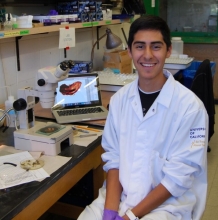
Major:
Mentor(s):
Faculty Sponsor(s):
Faculty Sponsor's Department(s):
Project Title:
Project Description:
Parasitic interactions play a large ecological role, but are unaccounted for in most food webs. In systems where parasites have been examined, parasites are usually most diverse in common hosts that are central in food webs. In the Santa Barbara kelp forests, the Senorita Wrasse (Oxyjulis californica) fills this role. Despite its abundance, there are no published records of endo-parasites for this fish. The objective of this study was to identify parasites using O. californica as a host, and use this data to inform construction of a more accurate kelp forest food web. O. californica were collected by trained divers by spear at two different kelp forests off the coast of Santa Barbara. I conducted a full parasitological assessment. Based off of the types of parasites found and published information on the diet of the fish, we created a list of possible predators/prey of O. californica. A total of 12 fish were dissected and 7 parasite groups were found. Three species of nematodes (Nematoda) had the highest frequency and were abundant in liver and stomach tissues. Larval tapeworms (Cestoda) were found in intestinal tissues along with fluke (Trematoda) cysts which were also located externally at the base of the fins. A single adult fluke was found in the body cavity presumably located in the urinary bladder. Spiny-headed worm (Acanthocephala) cysts were found in liver and stomach tissues. A few crustacean groups (Copepoda, Isopoda, Amphipoda) were attached externally. Associations were used to create links in the food web between predator/prey interactions.
